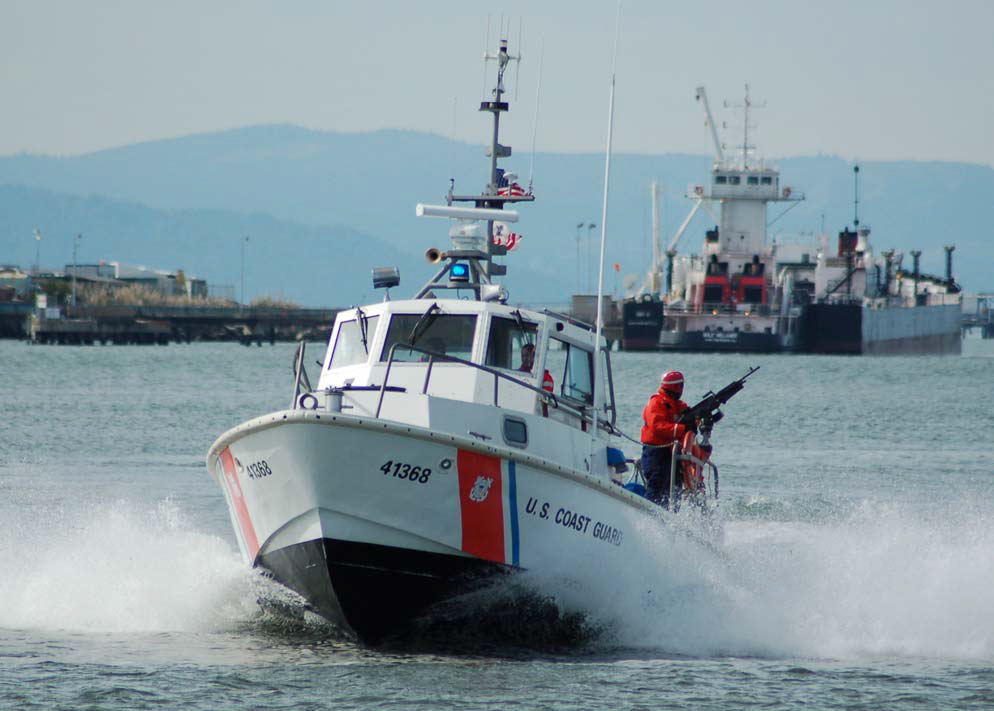
A changing and increasing mission workload throughout the 1960s and into the 70s led the Coast Guard to look for a replacement for its worn out and obsolete 40’ and 30’ utility boats. Starting in 1967, the agency embarked on what would become its last significant in-house design development effort for a replacement utility craft. The result of this became the 41’ Utility Boat-Large (UTB). (2)
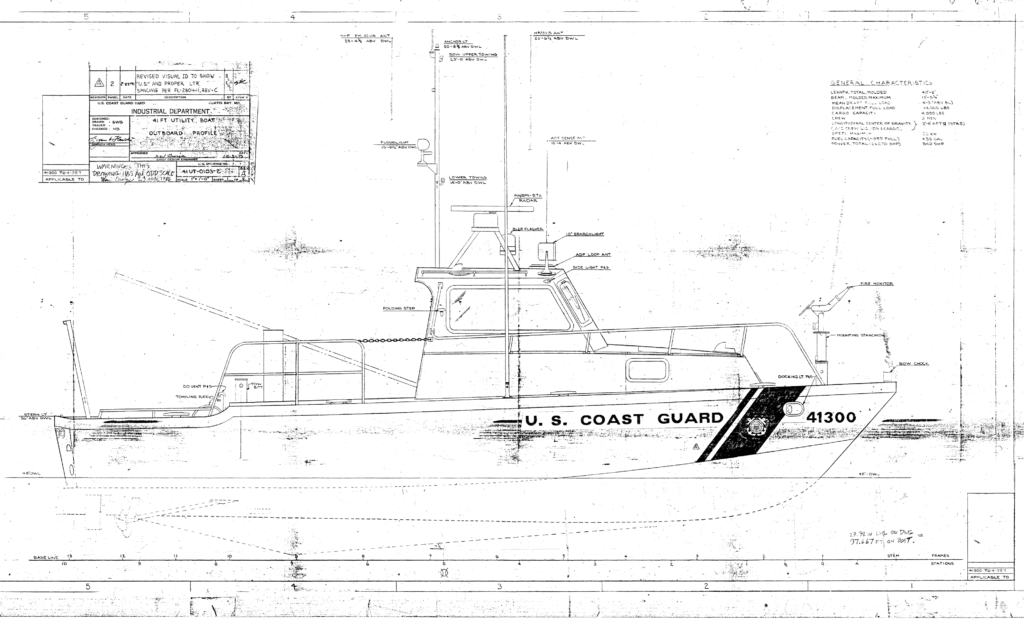
For this utility craft, the Coast Guard established the following general requirements:
-The boat had to be suitable for general use in search and rescue, as well as for law enforcement, nearshore patrol, and logistics duties.
-The design should provide a seaworthy boat capable of operations in mild to moderate weather and sea conditions without excessive pounding and with the boat staying dry.
-Twin diesel engine and twin propeller propulsion plant
-Watertight subdivision below the main deck, and an enclosed wheelhouse located in the forward half of the boat.
-Maximum speed of 24kts. in calm seas, and 18kts. in a 5-foot chop, with an endurance of about 300nm.
-Boat hull was to be constructed of aluminum alloy
-The boat had to have an improved firefighting capability by means of an installed pump and fire monitor
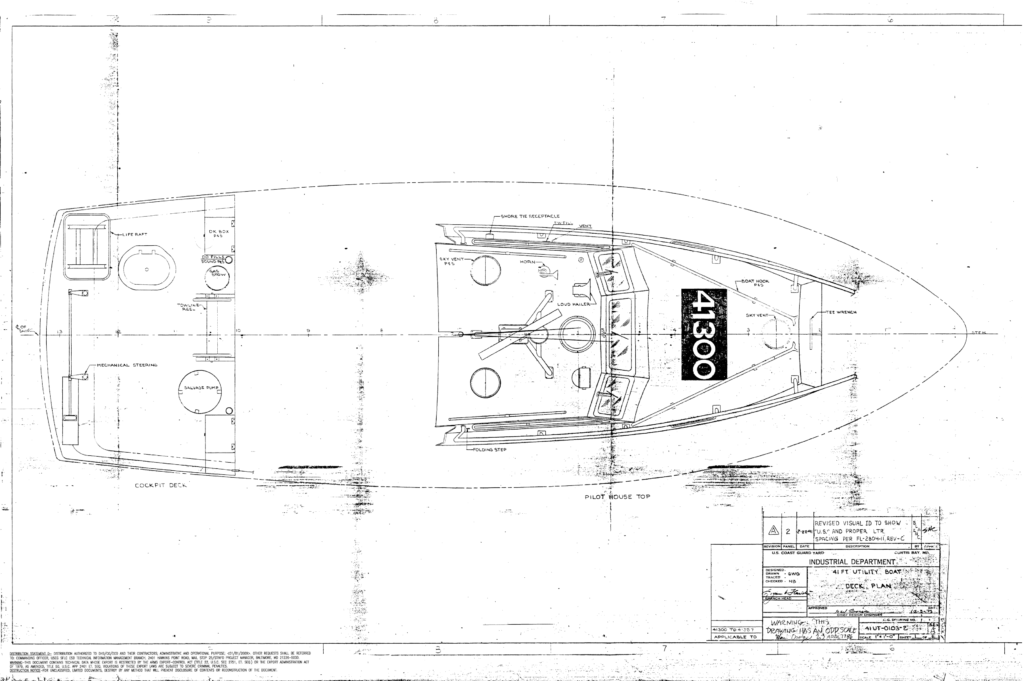
In 1969, authorization was given to procure four prototype boats, which were delivered in 1971. Two of these boats were off-the-shelf commercial design boats from private builders (CG-42047 from Swiftships Inc. of Morgan City, LA, and CG-42048 from Stewart Seacraft of Berwick, LA). The third boat was built to the Coast Guard’s design by the Curtis Bay Yard (CG-42046). The fourth boat was built by a private yard to a design developed by an outside design firm. These four boats, all of which were aluminum-hulled, then underwent extensive testing along the Atlantic coast for a period of four months by a select team of 12 expert coxswains.
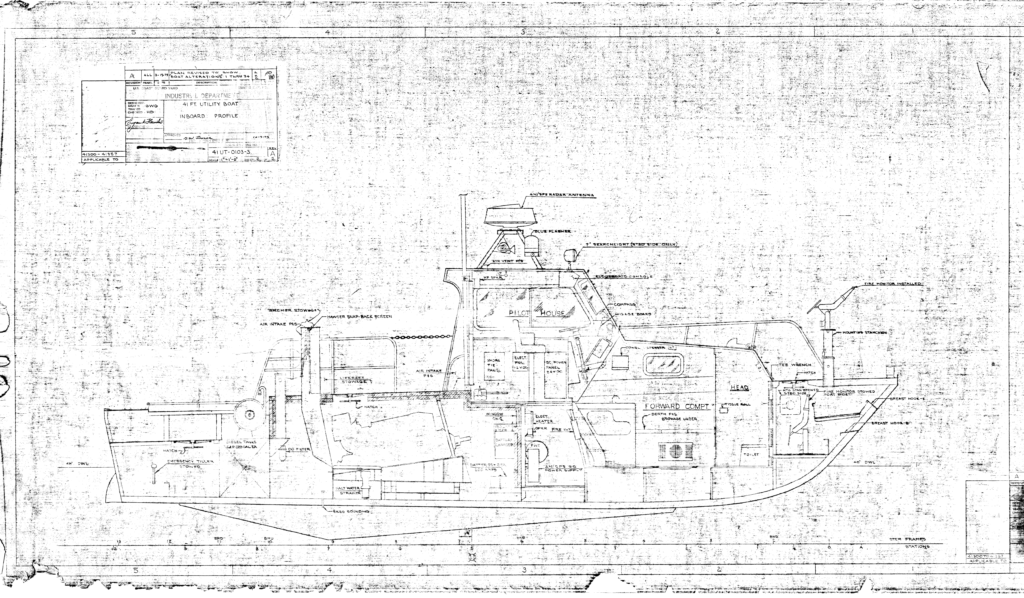
Based on test results, the Curtis Bay prototype was chosen for series production, with a total of 156 boats (CG-41300 through CG-41456) constructed between 1973 and 1978. This boat is 40’8″ in overall length, with a beam of 13’6″ and a draft of 4’. It is powered by either twin Cummins 280BHP diesel engines with a maximum speed of 22kts., or by twin Cummins 320BHP diesel engines with a maximum speed of 26kts. It carries 480 gallons of fuel.
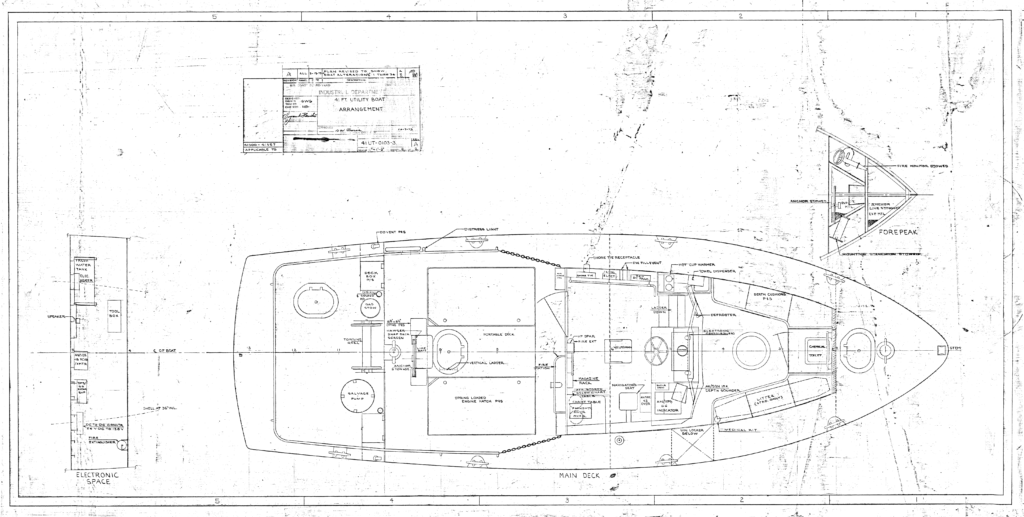
One improvement in design over the predecessor 40’ UTB was a modification to the size and freeboard of the aft cockpit. The size was reduced and the freeboard was increased slightly in order to reduce the risk of taking water over the stern when operating in following seas. In recognition of the expanded Coast Guard roles and responsibilities, the 41’ UTB was also better equipped than its predecessor 40’ UTB, with an improved electronics and communications suite, as well as an installed fire pump that had a capacity of 250 gallons per minute, with a bow-mounted fire monitor.
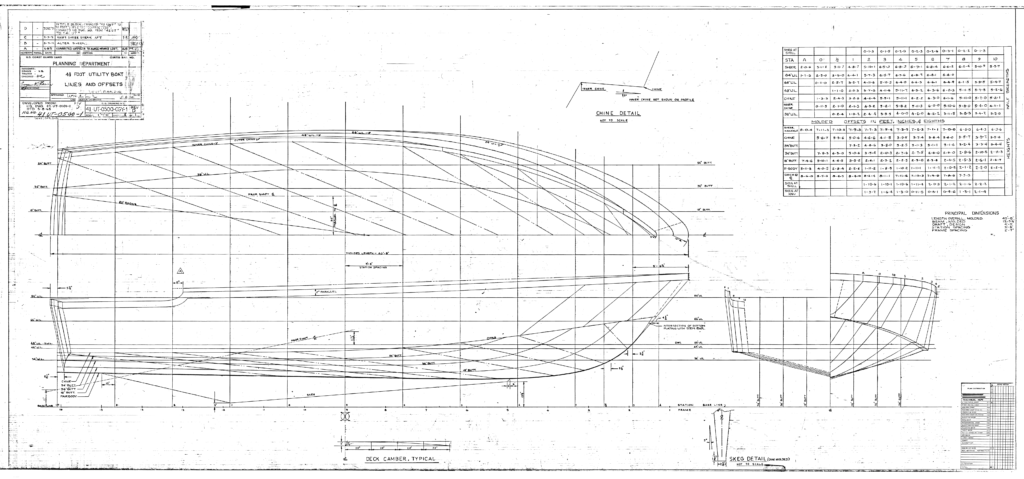
By the time the 41’ UTB began to be delivered in August of 1973, Coast Guard missions had evolved to include much more law enforcement work, including the need to chase down and intercept drug smuggler boats, which had significantly higher speed capabilities than the obsolete 40’ UTB. The 41’ UTB design offered higher speed and improved seaworthiness by use of a hard chine, planing hull with increased freeboard forward and amidships. Freeboard aft, while higher than the 40’ UTB, was still kept somewhat low to facilitate over-the-side work. More cabin space was provided, both for sheltering crew and survivors, as well as for accommodating the increased amount of electronic equipment and radios with which the 41’ UTB was equipped.
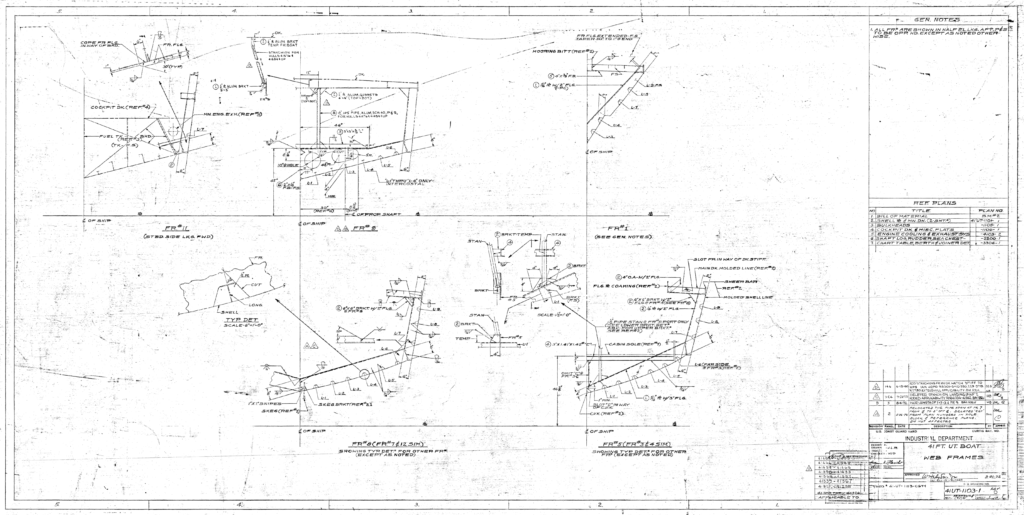
In service, 41’ UTB demonstrated a very rugged and seaworthy design. Although the boat is capable of surviving more extreme conditions, Coast Guard policy limited its use to conditions of 30 knots maximum wind and 8 foot maximum seas, and no breaking waves or surf. These were established following a tragic incident on 15 November 1977, when one boat (CG-41332) capsized with loss of life, showing that the 41’ UTB design was still vulnerable, like the 40’ UTB, to seas taken over the stern due to its lower freeboard aft. Starting in the early 1990s, minor stress cracks began to develop in the aluminum hulls of some boats from wear and tear, although these have been repaired through a careful program of inspection and welding. The Coast Guard in April 2003 issued a notice that it would begin replacing the 41′ UTBs with small and medium Response Boats. (9) The last 41′ UTB was retired in July 2014 in Grand Haven, Michigan. (10)
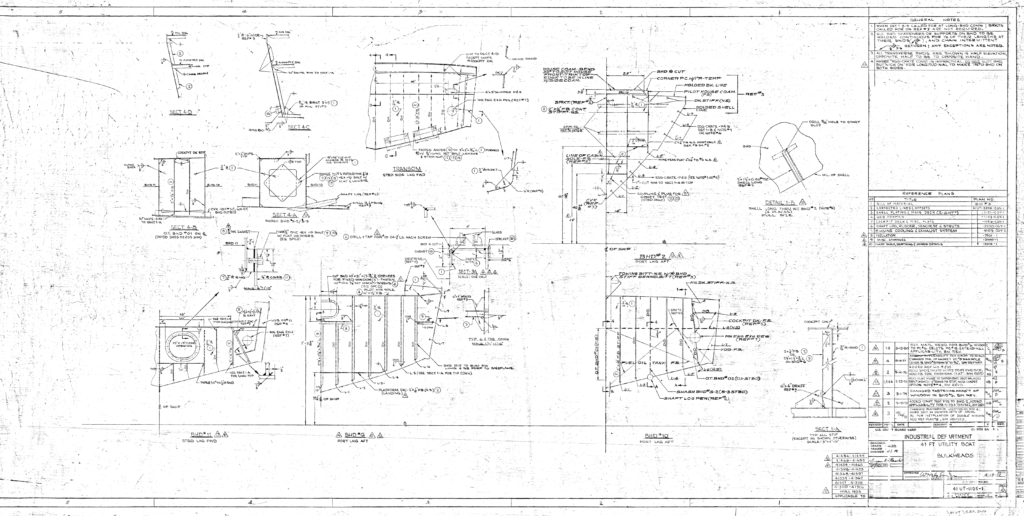
1. https://www.history.uscg.mil/Browse-by-Topic/Assets/Water/All/Boats-Less-than-65-ft/Article/2016262/boat-41-utility-boat-large-utb/) accessed 12/28/2021. NOTE: The appearance of U.S. Department of Defense (DoD) visual information does not imply or constitute DoD endorsement.
2. https://www.history.uscg.mil/Browse-by-Topic/Assets/Water/All/Boats-Less-than-65-ft/Article/2016262/boat-41-utility-boat-large-utb/ accessed 12/28/2021 Includes all information not otherwise footnoted.
3. https://media.defense.gov/2019/Nov/14/2002210729/-1/-1/0/41_FOOT_UTB_MODEL_PLANS.PDF accessed 12/28/2021
4. ibid
5. ibid
6. ibid
7. ibid
8. ibid
9. https://www.federalregister.gov/documents/2003/04/08/03-8524/response-boat-replacement-project-programmatic-environmental-assessment-and-finding-of-no Accessed 12/21/2021
10. https://www.wzzm13.com/article/news/local/grand-haven/coast-guard-retires-last-41-foot-utility-boat/69-415978526 accessed 12/28/2021
11. see footnote 3